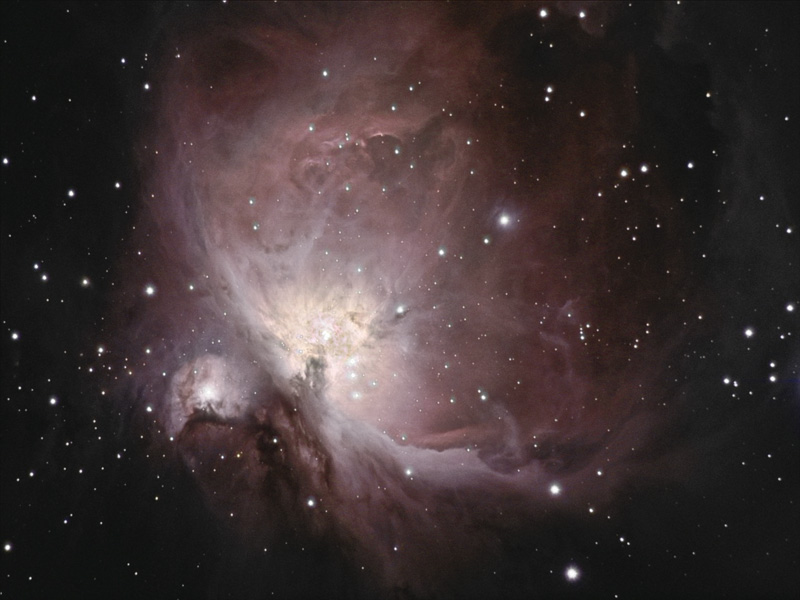
|
Le nebulose M 42 (NGC 1976) e
M 43 (NGC 1982) The M 42 (NGC 1976) and M 43 (NGC 1982) nebulas A.R. 05h35m18s - Decl. -05°23'00" |
|
Questa foto delle nebulose M42 e M43 in Orione è frutto dell'applicazione delle tecnologie CCD con la
pellicola chimica. Infatti la luminanza è derivata da un'acquisizione CCD effettuata da Marco Fazzoli e Riccardo Renzi il 26 settembre 2003, in occasione del primo Star Party del Monte Labro (GR) utilizzando una camera Sbig St2000XM applicata al fuoco diretto di un telescopio Schmidt Newton 200 mm F:4 su montatura GM2000 per un tempo di integrazione di 18 minuti e 40 secondi. La crominanza, invece, è il risultato della compositazione di più scatti. I primi sono stati scattati il 5 gennaio 2003 da Pontito (PT) al fuoco diretto di un telescopio Vixen R200SS (200 mm F:4) su montatura EQ6 e sono pose rispettivamente da 1 x 20 minuti, 1 x 15 minuti, 1 x 10 minuti e 2 x 5 minuti. Le esposizioni, tutte su pellicola Kodak Elitechrome 200 esposta a 320 ISO, sono state effettuate con inseguimento mediante rifrattore 80/910 in parallelo e reticolo illuminato Meade 12 mm. In seguito, per evidenziare la parte interna della nebulosa M42, sono state scattate altre due foto, rispettivamente da 5 minuti e da 30 secondi. Queste ultime sono state scattate il 30 agosto 2003 dal Monte Labro (GR) al fuoco diretto di un telescopio Vixen R200SS (200 mm F:4) su montatura EQ6 e Skysentor 2000 PC. Le esposizioni, su pellicola Fuji Provia 400F esposta a 400 ISO, sono state effettuate con inseguimento mediante rifrattore 80/910 in parallelo e proiettore di reticolo Vixen GA4. Successivamente le diapositive sono state scannerizzate con uno scanner dia Minolta Dimage Scan Dual III, e processata mediante applicazione di uno stretching, maschera sfocata e bilanciamento dei colori. Poi sono state compositate le varie immagini per evidenziare le varie parti delle nebulose. Da ultimo è stata effettuata la compositazione del file di luminanza con il file di crominanza mediante Maxim DL This photo of the M42 and M43 nebulas in Orion was realized joining the ccd technique and the common film photo. Infact the luminance is a ccd file taken by Marco Fazzoli and Riccardo Renzi on september 26 2003 during the first Star Party of Labro Mount, in Italy, near Grosseto, using a CCD camera Sbig St2000XM at the prime focus of a Schmidt Newton 200mm F:4 on GM2000 mount for 18 minutes and 40 seconds. The crominance file, instead, was realized adding more photos. The firsts were taken on january 5 2003 from Pontito, in Italy, near Pistoia, at the prime focus of a Vixen R200SS telescope (200 mm F:4) using a Syntha Eq6 mount and they are 1 x 20 minutes, 1 x 15 minutes, 1 x 10 minutes and 2 x 5 minutes photos. I exposed the film Kodak Elitechrome 200 at 320 ISO with a manual guide on a small refractor 80/910 and illuminated reticle eyepiece Meade 12 mm. Then, to point out the internal part of M42 nebula, I shot two more photos, one for 5 minutes and one for 30 seconds. I exposed these last on Fuji Provia 400 F film at 400 ISO at the prime focus of a Vixen R200SS telescope (200 mm F:4) using a Syntha Eq6 mount with Vixen Skysensor 2000 PC. I took the photos on august 30 2003 on the Labro Mount, in Italy, near Grosseto, with a manual guide on a small refractor 80/910 and a proiector of reticle Vixen GA4. Then I scanned the slide with a Minolta Dimage Scan Dual III scanner, and processed the file with a stretching, an unsharp mask and, last, a color balance. I joined the pics to point out the different parts of the nebula and, at last, the crominance and luminance files were composed using Maxim Dl Software. |